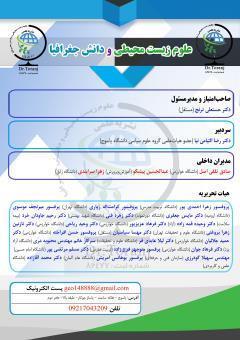توسعه و کاربرد مفهوم پنل خورشیدی ابریشم گرافن در طراحی ایستگاه اتوبوس هوشمند
محورهای موضوعی : علوم زیست محیطیکیانوش حسینیان 1 , سید مجید کشاورز 2
1 - دانشگاه فنی حرفه ای
2 - دانشگاه فنی و حرفه ای استان یاسوج، ایران،
کلید واژه: ابریشم گرافن, ریسندگی فیبر رباتیک, ایستگاه اتوبوس هوشمند, پنل های خورشیدی زیستی.,
چکیده مقاله :
با رشد مستمر جمعیت، با گسترش منطقه شهری. فعالیت ها و رفتارهای انسانی منابع محدود را از بین می برد، تعداد زیادی از این وسایل نقلیه شخصی جاده های ما را اشغال می کنند، همچنین باعث ایجاد مشکلات زیست محیطی مختلفی می شود. با افزایش آگاهی نسبت به حفاظت از محیط زیست، راه سفر سبز به تدریج به روشی برای سفر توسط مردم ساکن در کلان شهرها تبدیل شده است. راحتی و حفاظت از محیط زیست مزیت اصلی حمل و نقل عمومی است، اما متأسفانه، عملکرد، خدمات و محیط بسیاری از ایستگاه های اتوبوس راحت و دوستانه نیست. بنابراین، ایستگاه اتوبوس هوشمند متولد شد، نه تنها می تواند اطلاعات اتوبوس را در زمان واقعی ارائه دهد، بلکه فضای انتظار امن و راحت را نیز فراهم می کند. با این حال، با ارتقاء عملکردهای خدمات، مشکل مصرف انرژی به طور فزاینده ای برجسته شده است. تامین انرژی از طریق پنل های خورشیدی به طور طبیعی می تواند منبع انرژی پایداری برای ایستگاه های اتوبوس هوشمند باشد، اما بسیاری از مطالعات نشان داده اند که خود پنل های خورشیدی صرف نظر از مواد و قابلیت بازیافتشان، سازگار با محیط زیست نیستند. تحقیقات نویسنده نشان داد که مطالعات مربوطه تایید کردهاند که اسپری کردن محلول آبی حاوی نانولولههای کربنی یا گرافن روی برگهای توت برای تغذیه کرمهای ابریشم، چقرمگی تف ابریشم را دو برابر میکند و رسانایی ابریشم کربنی شده 10 برابر بیشتر است. علاوه بر این، فناوری ریسندگی الیاف روباتیک به کرمهای ابریشم اجازه میدهد تا به طور مستقل تولید اشیاء ابریشم را بدون کشتن کرمهای ابریشم تکمیل کنند. از طریق تحقیق بر روی مواد ابریشم گرافن و فناوری ریسندگی فیبر روباتیک، این مقاله یک راهحل مستقل بیولوژیکی برای تولید صفحات خورشیدی لایه نازک ابریشم گرافن پیشنهاد میکند تا به دنبال حل مشکل آلودگی پنلهای خورشیدی در ایستگاه هوشمند باشد.
With the continuous growth of the population, with the expansion of the urban area. Human activities and behaviors waste limited resources, a large number of these personal vehicles occupy our roads, also causing various environmental problems. With the increasing awareness of environmental protection, green travel has gradually become a way of travel for people living in big cities. Convenience and environmental protection are the main advantages of public transport, but unfortunately, the performance, service and environment of many bus stations are not comfortable and friendly. Therefore, the smart bus station was born, it can not only provide real-time bus information, but also provide a safe and comfortable waiting space. However, with the improvement of service functions, the problem of energy consumption has become increasingly prominent. Energy supply through solar panels can naturally be a sustainable energy source for smart bus stations, but many studies have shown that solar panels themselves are not environmentally friendly, regardless of their materials and recyclability. The author's research revealed that relevant studies have confirmed that spraying an aqueous solution containing carbon nanotubes or graphene on mulberry leaves to feed silkworms doubles the strength of silk spit and the conductivity of carbonized silk is 10 times higher. In addition, robotic fiber spinning technology allows silkworms to independently complete the production of silk objects without killing the silkworms. Through research on graphene silk materials and robotic fiber spinning technology, this paper proposes a biologically independent solution for the production of graphene silk thin film solar panels to seek to solve the problem of solar panel pollution in the smart station.
[1] Reconnecting America. Sustain Urban Des Transit 2011.
[2] Arora S. Designing a smart bus stop for metropolitans and Tier-1 cities of India. 2014.
[3] Can C. Strong reduced graphene oxide coated bombyx mori silk. Adv Funct Mater 2021;31.
[4] Erteza E. A review of primary technologies of thin-film solar cells. Eng Res Express 2021;3.
[5] Yue Z, Qunwei T, Benlin He, Peizhi Y. Graphene enabled all-weather solar cells for electricity harvest from sun and rain. J Mater Chem 2016;4.
[6] Marika E. Thin film solar cells: Research in an industrial perspective. Ambio 2012;41.
[7] Ashwin M, Mounika V, Kommineni M, Swetha K. Secure design for smart bus shelter using renewable energy. J Crit Rev 2020;7(1).
[8] Xie Z. Research on bus passenger flow analysis method based on intelligent transportation. IOP Conf Ser Earth Environ Sci 2020;440.
[9] Miraal K. IoT based smart city bus stops. MDPI J Future Internet 2019;11(227).
[10] Xiaoguang C, Jinting S, Xufeng T, Heqi L. The sustainable development of smart cities: A case study of the design of driverless bus stops in Zhengzhou. E3S Wen Conf 2021;293.
[11] TransLink. Transit passenger facility design guidelines. 2011, October.
[12] Code for fire protection design of buildings. GB50016-2014, 2018.
[13] Haifeng L. Aligned Graphene/silk fibroin conductive fibrous scaffolds for guiding Neurite outgrowth in rat spinal cord neurons. J Biomed Mater Res 2021.
[14] Oxman N. Templating design for biology and biology for design. Cambridge, Massachusetts: Oxman/MIT Mediated. Matter Group and Professor Massachusetts Institute of Technology (MIT); 2015.


